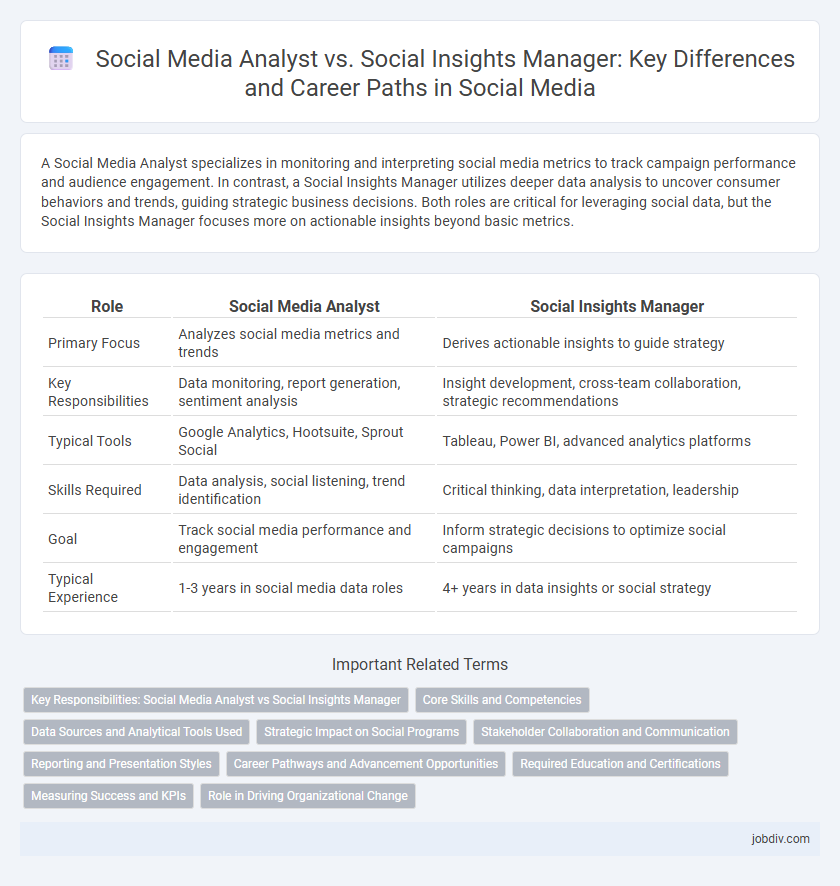A Social Media Analyst specializes in monitoring and interpreting social media metrics to track campaign performance and audience engagement. In contrast, a Social Insights Manager utilizes deeper data analysis to uncover consumer behaviors and trends, guiding strategic business decisions. Both roles are critical for leveraging social data, but the Social Insights Manager focuses more on actionable insights beyond basic metrics.
Table of Comparison
| Role | Social Media Analyst | Social Insights Manager |
|---|---|---|
| Primary Focus | Analyzes social media metrics and trends | Derives actionable insights to guide strategy |
| Key Responsibilities | Data monitoring, report generation, sentiment analysis | Insight development, cross-team collaboration, strategic recommendations |
| Typical Tools | Google Analytics, Hootsuite, Sprout Social | Tableau, Power BI, advanced analytics platforms |
| Skills Required | Data analysis, social listening, trend identification | Critical thinking, data interpretation, leadership |
| Goal | Track social media performance and engagement | Inform strategic decisions to optimize social campaigns |
| Typical Experience | 1-3 years in social media data roles | 4+ years in data insights or social strategy |
Key Responsibilities: Social Media Analyst vs Social Insights Manager
Social Media Analysts primarily monitor and analyze social media metrics, track campaign performance, and generate detailed reports to inform marketing strategies. Social Insights Managers focus on interpreting broader consumer behavior trends, integrating data across multiple platforms, and providing strategic recommendations to guide business decisions. Both roles require expertise in data analytics, but Social Insights Managers emphasize actionable insights and strategic impact beyond social media metrics.
Core Skills and Competencies
Social Media Analysts excel in data analysis, trend identification, and performance tracking using tools like Google Analytics and social listening platforms to optimize content strategies. Social Insights Managers prioritize strategic thinking, consumer behavior analysis, and cross-team collaboration to translate data into actionable business insights. Both roles require strong communication skills and proficiency in data visualization but differ in focus: analysts emphasize technical data handling while insights managers concentrate on integrating social data into broader marketing objectives.
Data Sources and Analytical Tools Used
Social Media Analysts primarily leverage platforms like Google Analytics, Hootsuite, and social listening tools such as Brandwatch to gather and interpret real-time data from social channels. Social Insights Managers utilize more advanced analytics software including Tableau, SAS, and proprietary CRM systems to integrate multiple data sources and generate comprehensive audience insights. Both roles rely heavily on sentiment analysis, engagement metrics, and demographic data, but Insights Managers emphasize strategic data synthesis for long-term decision-making.
Strategic Impact on Social Programs
A Social Media Analyst focuses on gathering and analyzing real-time social data to optimize content performance and audience engagement, driving tactical decisions for social campaigns. In contrast, a Social Insights Manager leverages deeper trend analysis and consumer behavior patterns to inform long-term strategies, shaping the overall direction of social programs. The strategic impact of a Social Insights Manager is broader, influencing organizational objectives and brand positioning beyond immediate social media metrics.
Stakeholder Collaboration and Communication
Social Media Analysts specialize in data collection and real-time performance tracking, providing stakeholders with detailed reports to inform tactical decisions. Social Insights Managers interpret these analytics to develop strategic narratives that align with business goals, ensuring clear communication and collaboration across cross-functional teams. Effective stakeholder collaboration in both roles demands precise data translation and ongoing dialogue to drive actionable outcomes and enhance brand impact.
Reporting and Presentation Styles
Social Media Analysts specialize in data-driven reporting, utilizing quantitative metrics and dashboard tools to track campaign performance and audience engagement in real time. Social Insights Managers emphasize qualitative analysis by interpreting data trends through comprehensive presentations that connect social metrics to broader business objectives and market strategies. The contrast in presentation styles lies in the Analyst's concise, metric-focused reports versus the Insights Manager's narrative-driven insights designed to influence strategic decision-making.
Career Pathways and Advancement Opportunities
Social Media Analysts focus on data collection and trend analysis to optimize content strategies, providing a foundation for advancing into a Social Insights Manager role, which oversees broader strategic decision-making and cross-departmental collaboration. Career pathways typically progress from entry-level analysis roles to managerial positions emphasizing leadership, business intelligence, and market forecasting skills. Advancement opportunities include specializing in consumer behavior analytics or expanding into digital marketing strategy, with potential growth into director-level positions overseeing comprehensive social media and consumer insights functions.
Required Education and Certifications
A Social Media Analyst typically requires a bachelor's degree in marketing, communications, or data analytics, with certifications like Google Analytics or Facebook Blueprint enhancing their credentials. In contrast, a Social Insights Manager often holds advanced degrees such as a master's in business analytics, market research, or social sciences, alongside certifications like Certified Market Research Analyst (CMRA) or Hootsuite Social Marketing Certification. Both roles benefit from expertise in data interpretation and social media strategy, but the Social Insights Manager demands deeper analytical skills and leadership-focused qualifications.
Measuring Success and KPIs
Social Media Analysts primarily measure success through quantitative KPIs such as engagement rates, click-through rates, and follower growth to assess campaign performance and audience behavior. Social Insights Managers dive deeper into data interpretation, focusing on qualitative insights from customer sentiment, market trends, and competitive analysis to inform strategic decision-making. Both roles rely on metrics like conversion rates and ROI, but Social Insights Managers translate these metrics into actionable strategies that drive business growth.
Role in Driving Organizational Change
A Social Media Analyst focuses on monitoring metrics, analyzing audience engagement, and providing data-driven reports to improve content strategies. A Social Insights Manager leverages these analytical insights to influence strategic decision-making and drive organizational change by aligning social media initiatives with broader business goals. Both roles are essential for transforming social data into actionable strategies that support innovation and competitive advantage.
Social Media Analyst vs Social Insights Manager Infographic

 jobdiv.com
jobdiv.com